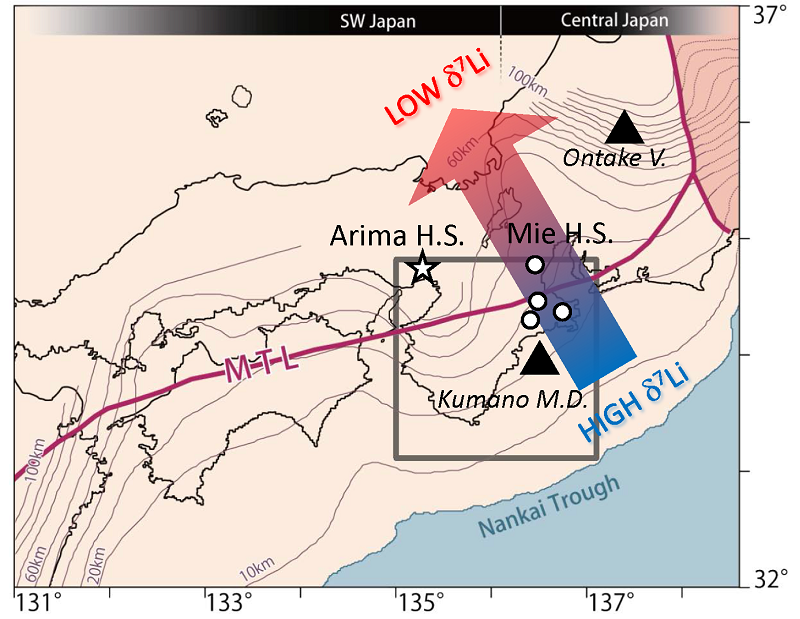
Lithium isotope systematics of Arima hot spring waters and groundwaters in Kii Peninsula
ABSTRACT

Slab-dehydrated fluid is considered to be involved in island arc magmatism. In this study, Li isotope ratios were determined for deep groundwater samples from the non-volcanic forearc region of SW Japan. The contribution of the slab-dehydrated fluid from the Philippine Sea Plate (PHS) was investigated in the Arima area and the eastern Kii Peninsula area, corresponding to the slab depths of ~60 km and 20–30 km, respectively. In the Arima area, the high-temperature thermal waters with high salinity called the Arima-type fluid were clarified to have low δ7Li values of +1–+3‰. The low δ7Li values with high Li concentrations are thought to be the result of fluid-rock interactions at high temperatures, which is consistent with the characteristics of the slab-dehydrated fluid. On the other hand, the δ7Li values of deep groundwaters in the eastern Kii Peninsula showed a wide range of +2 to +29‰. Several groundwater samples had a similar chemical property to the Arima-type fluid: low δ7Li values, low Cl/Li ratios, and 87Sr/86Sr ratios around 0.708–0.710. They are distributed along the Median Tectonic Line (MTL) and within about 20 km south of the MTL. These results indicate a common supply of slab-dehydrated fluids to the non-volcanic forearc region in SW Japan from PHS along the large faults, and Li isotope ratios will be a useful indicator to detect their contribution.
KEYWORDS
Keywords: slab-dehydrated fluid, groundwater, isotopic tracer, Arima hot spring, Li isotope- Published : 2022
- Released on J-STAGE : 2022/10/18
- Received : 2021/12/27
- Accepted : 2022/08/13
- DOI : https://doi.org/10.2343/geochemj.GJ22015
- J-STAGE URL : https://www.jstage.jst.go.jp/article/geochemj/56/5/56_GJ22015/_article/-char/en
- J-Online ISSN: 1880-5973
- Print ISSN : 0016-7002
- ISSN-L : 0016-7002
All Issues
- Vol.59, 2025
- Vol.58, 2024
- Vol.57, 2023
- Vol.56, 2022
- Vol.55, 2021
- Vol.54, 2020
- Vol.53, 2019
- Vol.52, 2018
- Vol.51, 2017
- Vol.50, 2016
- Vol.49, 2015
- Vol.48, 2014
- Vol.47, 2013
- Vol.46, 2012
- Vol.45, 2011
- Vol.44, 2010
- Vol.43, 2009
- Vol.42, 2008
- Vol.41, 2007
- Vol.40, 2006
- Vol.39, 2005
- Vol.38, 2004
- Vol.37, 2003
- Vol.36, 2002
- Vol.35, 2001
- Vol.34, 2000
- Vol.33, 1999
- Vol.32, 1998
- Vol.31, 1997
- Vol.30, 1996
- Vol.29, 1995
- Vol.28, 1994
- Vol.27, 1993
- Vol.26, 1992
- Vol.25, 1991
- Vol.24, 1990
- Vol.23, 1989
- Vol.22, 1988
- Vol.21, 1987
- Vol.20, 1986
- Vol.19, 1985-1986
- Vol.18, 1984
- Vol.17, 1983
- Vol.16, 1982
- Vol.15, 1981
- Vol.14, 1980
- Vol.13, 1979
- Vol.12, 1978
- Vol.11, 1977
- Vol.10, 1976
- Vol.9, 1975
- Vol.8, 1974
- Vol.7, 1973
- Vol.6, 1972-1973
- Vol.5, 1971
- Vol.4, 1970-1971
- Vol.3, 1969-1970
- Vol.2, 1968
- Vol.1, 1966-1967




